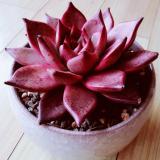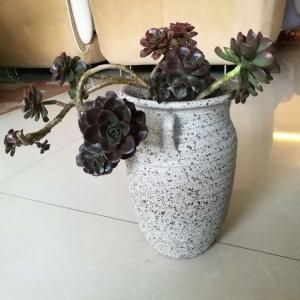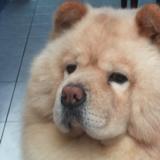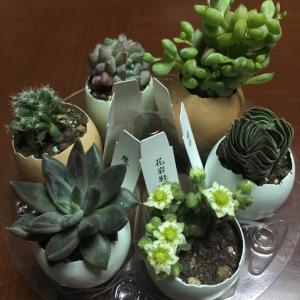文章
Miss Chen
2017年12月19日

Description: This annual plant sprawls across the ground, forming a low mat of leafy stems up to 12" across. The central stem divides early, forming numerous lateral stems that also divide. The stems are terete, pale red, and hairless. At intervals, pairs of opposite leaves occur along the stems that are ¼-¾" in length; they are about 3 times as long as they are across. Individual leaves are narrowly oblong in shape and smooth along their margins; there is a tendency for the lower half of a leaf to be slightly wider than its upper half. The upper leaf surface is medium green and hairless, while the lower surface is pale green and hairless. At the base of each leaf, there is a short slender petiole. White to light green stipules occur below pairs of new leaves; the stipules are sharply and deeply cleft into linear to lanceolate lobes with narrow pointed tips. These stipules soon wither away. Both the stems and the leaves exude a milky latex when they become damaged.
Tiny flowers with cyathia (cup-like structures) develop near pairs of leaves; there is normally only a single cyathium (cup-like structure) per pair of leaves. The cyathium is less than 2 mm. long; its outer surface is light green and hairless. Each cyathium has a short stalk at its base that is terete and pale red. Along the upper rim of the cyathium, there are 4 nectar glands with tiny petaloid appendages. These petaloid appendages are white and barely perceptible without magnification; sometimes they are absent. Between the nectar glands along the upper rim of the cyathium, there are tiny linear-lanceolate lobes that are erect. From the center of the cyathium, there develops a single female flower on a short stout pedicel that becomes more long and curved with age. The female flower consists of a naked 3-celled ovary with a short tripartite style at its apex. This ovary is light green, hairless, and globoid in shape. Several male flowers develop underneath the female flower within the cyathium; each male flower consists of a single stamen. The blooming period occurs from mid-summer into the fall. The ovaries of female flowers develop into seed capsules about 1/8" (3.0-3.5 mm.) across; these capsules are globoid with 3 shallow longitudinal lobes and they are hairless. Each cell of a capsule contains 1-2 seeds that are 2.0-2.5 mm. long, narrowly ovoid in shape, and relatively smooth (although minutely pitted under magnification). Seeds are ejected from their capsules at maturity. The root system consists of a slender branching taproot. This plant spreads by reseeding itself.
Cultivation: The preference is full sun, mesic to dry conditions, and very sandy soil. This little plant has a C4 metabolism, which enables it to withstand hot dry conditions.

Range & Habitat: The native Seaside Spurge is found primarily along Lake Michigan; it has also been found in Fulton County, although this interior location is highly unusual for this species (see Distribution Map). Seaside Spurge is rare in Illinois and state-listed as 'endangered.' Outside of the state, this species is found along the coastal areas of the Great Lakes (except for Lake Superior) and it is also found along the Atlantic coast, particularly in sandy areas such as beaches. In Illinois, habitats consist of sandy beaches along Lake Michigan, sand dunes near Lake Michigan, and a dry sand prairie in Fulton County. This plant is very specialized in its habitat preferences; it is vulnerable to development in coastal areas and trampling by people along beaches.
Faunal Associations: The flowers attract small bees and flies (mainly Syrphidae). These insects obtain nectar from the flowers; in addition, the bees may collect pollen. Insects that feed on the foliage or plant juices of Chamaesyce spp. (Prostrate Spurges) include the aphid Macrosiphum euphorbiae, the plant bug Semium hirtum, and the leaf beetle Glyptina leptosoma. Bird that eat the seeds of these plants include the Greater Prairie Chicken, Northern Bobwhite, Horned Lark, Chipping Sparrow, and Mourning Dove. Because the seeds have oily elaiosomes, they are dispersed to some extent by ants.

Photographic Location: A sandy beach at Indiana Dunes State Park in NW Indiana.
Comments: Some authorities refer to this species as Euphorbia polygonifolia. Seaside Spurge is a member of a small group of prostrate spurges (Chamaesyce spp.) that are often difficult to distinguish. They are mainly native to Illinois, although a few species are adventive from the western states. Seaside Spurge can be be distinguished from most species in this genus by its hairless leaves and stems, its hairless ovaries and seed capsules, and the smooth toothless margins of its leaves. Another prostrate spurge, Chamaesyce geyeri (Geyer's Spurge), also has these characteristics, but its seeds (about 1.5 mm. long) and seed capsules (2.0-2.5 mm. long) are smaller in size than those of Seaside Spurge.
Tiny flowers with cyathia (cup-like structures) develop near pairs of leaves; there is normally only a single cyathium (cup-like structure) per pair of leaves. The cyathium is less than 2 mm. long; its outer surface is light green and hairless. Each cyathium has a short stalk at its base that is terete and pale red. Along the upper rim of the cyathium, there are 4 nectar glands with tiny petaloid appendages. These petaloid appendages are white and barely perceptible without magnification; sometimes they are absent. Between the nectar glands along the upper rim of the cyathium, there are tiny linear-lanceolate lobes that are erect. From the center of the cyathium, there develops a single female flower on a short stout pedicel that becomes more long and curved with age. The female flower consists of a naked 3-celled ovary with a short tripartite style at its apex. This ovary is light green, hairless, and globoid in shape. Several male flowers develop underneath the female flower within the cyathium; each male flower consists of a single stamen. The blooming period occurs from mid-summer into the fall. The ovaries of female flowers develop into seed capsules about 1/8" (3.0-3.5 mm.) across; these capsules are globoid with 3 shallow longitudinal lobes and they are hairless. Each cell of a capsule contains 1-2 seeds that are 2.0-2.5 mm. long, narrowly ovoid in shape, and relatively smooth (although minutely pitted under magnification). Seeds are ejected from their capsules at maturity. The root system consists of a slender branching taproot. This plant spreads by reseeding itself.
Cultivation: The preference is full sun, mesic to dry conditions, and very sandy soil. This little plant has a C4 metabolism, which enables it to withstand hot dry conditions.

Range & Habitat: The native Seaside Spurge is found primarily along Lake Michigan; it has also been found in Fulton County, although this interior location is highly unusual for this species (see Distribution Map). Seaside Spurge is rare in Illinois and state-listed as 'endangered.' Outside of the state, this species is found along the coastal areas of the Great Lakes (except for Lake Superior) and it is also found along the Atlantic coast, particularly in sandy areas such as beaches. In Illinois, habitats consist of sandy beaches along Lake Michigan, sand dunes near Lake Michigan, and a dry sand prairie in Fulton County. This plant is very specialized in its habitat preferences; it is vulnerable to development in coastal areas and trampling by people along beaches.
Faunal Associations: The flowers attract small bees and flies (mainly Syrphidae). These insects obtain nectar from the flowers; in addition, the bees may collect pollen. Insects that feed on the foliage or plant juices of Chamaesyce spp. (Prostrate Spurges) include the aphid Macrosiphum euphorbiae, the plant bug Semium hirtum, and the leaf beetle Glyptina leptosoma. Bird that eat the seeds of these plants include the Greater Prairie Chicken, Northern Bobwhite, Horned Lark, Chipping Sparrow, and Mourning Dove. Because the seeds have oily elaiosomes, they are dispersed to some extent by ants.

Photographic Location: A sandy beach at Indiana Dunes State Park in NW Indiana.
Comments: Some authorities refer to this species as Euphorbia polygonifolia. Seaside Spurge is a member of a small group of prostrate spurges (Chamaesyce spp.) that are often difficult to distinguish. They are mainly native to Illinois, although a few species are adventive from the western states. Seaside Spurge can be be distinguished from most species in this genus by its hairless leaves and stems, its hairless ovaries and seed capsules, and the smooth toothless margins of its leaves. Another prostrate spurge, Chamaesyce geyeri (Geyer's Spurge), also has these characteristics, but its seeds (about 1.5 mm. long) and seed capsules (2.0-2.5 mm. long) are smaller in size than those of Seaside Spurge.
0
0
文章
Miss Chen
2017年12月18日

Description: This perennial wildflower consists of a low rosette of basal leaves up to 1½' across and a flowering stalk about 1½–2' tall. The floppy basal leaves are 6-12" long and 1/3" (8 mm.) across; they are medium to dark green, linear in shape, parallel-veined, glabrous, and smooth along their margins. Along the underside of each basal leaf, there is a prominent mid-rib. The erect central stalk is slender, light to medium green, and glabrous; it terminates in a spike-like raceme of flowers that is several inches in length. Underneath the floral spike, there are usually 1-3 bracts along the stalk. These bracts are green, linear to linear-lanceolate in shape, and up to ¾" long. Each flower is ¾–1" across, consisting of 6 tepals, 6 stamens with bright yellow anthers, and a green central ovary with a slender style. The tepals are light blue-violet to nearly white; they are oblong in shape and spread widely from the center of the flower. Each tepal (petal or petal-like sepal) has 1-3 poorly defined veins along its length.

At the base of each flower, there is a single linear bract up to ¾" long that is early-deciduous. The slender pedicel of each flower is about the same length as the bract. The flowers begin to bloom from the bottom of the raceme and continue to bloom upward toward the apex; each flower lasts only 2-3 days. The blooming period occurs from mid- to late spring and lasts about 2-3 weeks. Each fertilized flower is replaced by a 3-celled seed capsule that is about 1/3" in length and nearly as much across. Each seed capsule contains many small seeds that are black and shiny. The basal leaves turn yellow and wither away by mid-summer. The root system consists of a bulb with fibrous roots. This wildflower reproduces by reseeding itself.
Cultivation: The preference is full sun to light shade, moist conditions, and rich loamy soil. Wild Hyacinth is slow to develop, but fairly long-lived. Vegetative growth and development occurs during the cool weather of spring, when adequate moisture is essential.
Range & Habitat: Wild Hyacinth is found occasionally throughout Illinois (see Distribution Map), where it is native. Habitats include moist black soil prairies, moist savannas, moist open woodlands (particularly along the banks of streams), rocky wooded slopes, and limestone glades. This species is typically found in high quality habitats, whether prairies or woodlands.
Faunal Associations: The flowers attract their fair share of insects, including many bees and flies, and occasional butterflies and wasps. Most of these insects seek nectar from the flowers, although some short-tongued bees also collect pollen. Bee visitors include honeybees, bumblebees, Cuckoo bees (Nomada spp.), and Halictid bees (Halictus spp., Lasioglossum spp., etc.). Other floral-faunal relationships are poorly understood. White-Tailed Deer occasionally chomp off the tops of the basal leaves. Both the foliage and bulbs are not known to be toxic to mammalian herbivores.
Photographic Location: Along a woodland stream in Douglas or Coles County in east-central Illinois.

Comments: Wild Hyacinth has attractive flowers that are conspicuous during the spring. It is usually found in woodland habitats, but also occurs in prairies. Wild Hyacinth differs from the less common Camassia angusta (Prairie Hyacinth) in several ways, among them: 1) It has slightly larger flowers than the latter, 2) its flowers are usually a slightly lighter shade of blue-violet, 3) its seed capsules are about as broad as long, while Prairie Hyacinth has seed capsules that are slightly longer than broad, 4) the bracts of its flowering stalk are less persistent than those of Prairie Hyacinth, and 5) it blooms earlier in the spring.

At the base of each flower, there is a single linear bract up to ¾" long that is early-deciduous. The slender pedicel of each flower is about the same length as the bract. The flowers begin to bloom from the bottom of the raceme and continue to bloom upward toward the apex; each flower lasts only 2-3 days. The blooming period occurs from mid- to late spring and lasts about 2-3 weeks. Each fertilized flower is replaced by a 3-celled seed capsule that is about 1/3" in length and nearly as much across. Each seed capsule contains many small seeds that are black and shiny. The basal leaves turn yellow and wither away by mid-summer. The root system consists of a bulb with fibrous roots. This wildflower reproduces by reseeding itself.
Cultivation: The preference is full sun to light shade, moist conditions, and rich loamy soil. Wild Hyacinth is slow to develop, but fairly long-lived. Vegetative growth and development occurs during the cool weather of spring, when adequate moisture is essential.
Range & Habitat: Wild Hyacinth is found occasionally throughout Illinois (see Distribution Map), where it is native. Habitats include moist black soil prairies, moist savannas, moist open woodlands (particularly along the banks of streams), rocky wooded slopes, and limestone glades. This species is typically found in high quality habitats, whether prairies or woodlands.
Faunal Associations: The flowers attract their fair share of insects, including many bees and flies, and occasional butterflies and wasps. Most of these insects seek nectar from the flowers, although some short-tongued bees also collect pollen. Bee visitors include honeybees, bumblebees, Cuckoo bees (Nomada spp.), and Halictid bees (Halictus spp., Lasioglossum spp., etc.). Other floral-faunal relationships are poorly understood. White-Tailed Deer occasionally chomp off the tops of the basal leaves. Both the foliage and bulbs are not known to be toxic to mammalian herbivores.
Photographic Location: Along a woodland stream in Douglas or Coles County in east-central Illinois.

Comments: Wild Hyacinth has attractive flowers that are conspicuous during the spring. It is usually found in woodland habitats, but also occurs in prairies. Wild Hyacinth differs from the less common Camassia angusta (Prairie Hyacinth) in several ways, among them: 1) It has slightly larger flowers than the latter, 2) its flowers are usually a slightly lighter shade of blue-violet, 3) its seed capsules are about as broad as long, while Prairie Hyacinth has seed capsules that are slightly longer than broad, 4) the bracts of its flowering stalk are less persistent than those of Prairie Hyacinth, and 5) it blooms earlier in the spring.
0
0
文章
Miss Chen
2017年12月16日


紫花凤梨体型不大,株高不及30厘米。叶窄线形,长20厘米-30厘米,宽1-1.5厘米,簇生,浓绿色,质硬面是凹弧状,中部带有紫褐色斑晕背绿褐色。花序梗自叶丛中抽生,长约20厘米,顶端12-15厘米处扁平,形成穗状花序,宽4-4.5厘米,由粉红色近淡紫色的苞片对生组;青紫色小花由苞片内开出,约20朵之多,花瓣卵形,3片;冠径约3厘米,形似蝴蝶。苞片可观赏达数月之久。

紫花凤梨是否有毒?
放在卧室内的植物我们首先会问的是植物是否有毒,其毒主要是所散发的气体,其实紫花凤梨在这方面并没有毒,反倒是可以吸收有害气体。但是植物本身有无毒,还没有明确的研究,养花的友友们也不会想去咬一口试试其植物本身有无毒吧,所以在不伤害植物的情况下,可以放心养殖。
能否放在卧室养殖?
可以放在卧室养殖,但卧室的空间若较小的,就不建议放进去了,除了紫花凤梨,其它植物也不建议摆放,可以白天移至卧室摆放,夜间移至客厅摆放。
从养殖紫花凤梨的角度来说,紫花凤梨需要良好的通风环境,而夜间的卧室相对来说通风环境较差,这很容易造成紫花凤梨的徒长,使它的花穗渐渐缩短,叶形也会变得较窄较长,花朵也会失去以往的光鲜亮丽,最主要的是特别容易引发病虫害,尤其是夏季,最为严重;放在卧室还需要注意的是光照,光照适合的情况下,花朵会变大,其颜色会更加鲜艳,外形也会越来越紧凑,但是要避开午间前后的阳光。
对于紫花凤梨可以放卧室这个问题就解说到这里,友友们可以根据自己的实际情况来决定要不要放在卧室内养殖。
0
0


















